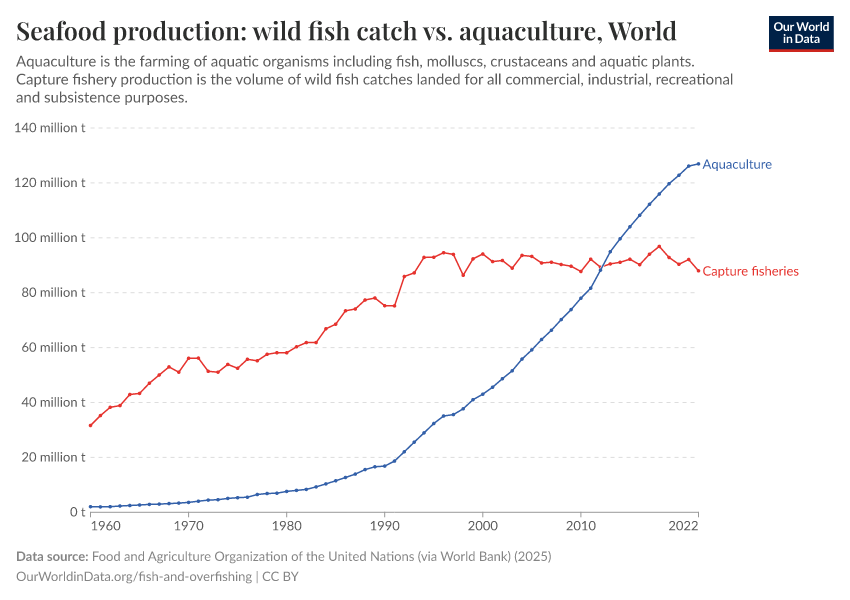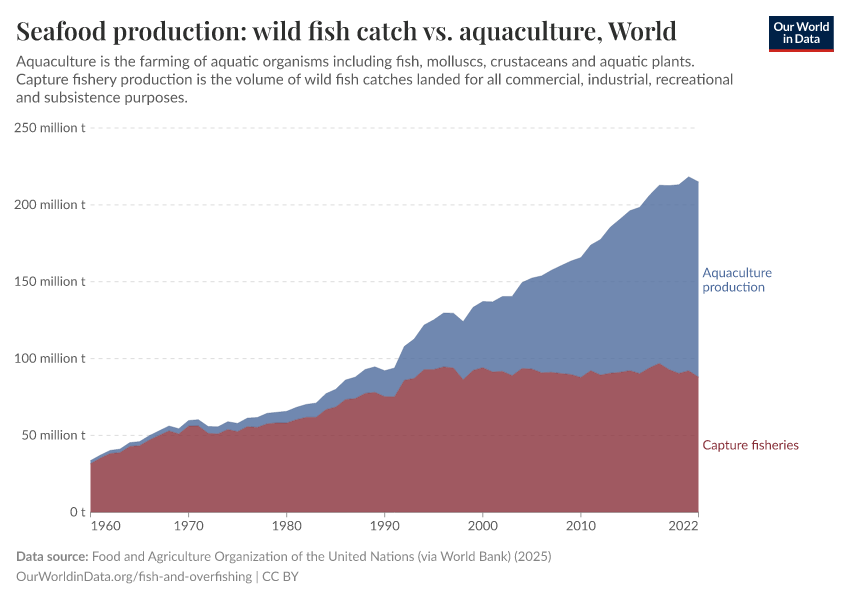The world now produces more seafood from fish farms than wild catch
Growing demand for seafood has placed increasing pressures on wild fish populations. One innovation has helped to alleviate some of the pressure on wild fish catch: aquaculture, the practice of fish and seafood farming. Aquaculture production has now overtaken wild fish catch.
Global production of fish and seafood has quadrupled over the past 50 years. Not only has the world population more than doubled over this period, the average person now eats almost twice as much seafood as half a century ago.
This has increased pressure on fish stocks across the world. Globally, the share of fish stocks which are overexploited – meaning we catch them faster than they can reproduce to sustain population levels – has more than doubled since the 1980s and this means that current levels of wild fish catch are unsustainable.
One innovation has helped to alleviate some of the pressure on wild fish catch: aquaculture, the practice of fish and seafood farming. The distinction between farmed fish and wild catch is similar to the difference between raising livestock rather than hunting wild animals. Except that for land-based animals, farming is many thousand years old while it was very uncommon for seafood until just over 50 years ago.
In the visualizations we see the change in aquaculture and capture fishery production from 1960 onwards. What’s striking is that global wild fish catch has not increased since the early 1990s and instead remained relatively constant at around 90 to 95 million tonnes per year. Fish farming on the other hand is growing very rapidly, from 1960 until 2015 it has increased 50-fold to over 100 million per year.
In the 1960s, aquaculture was relatively niche, with an output of a few million tonnes per year. Particularly since the late 1980s, annual production has increased rapidly. In 1990 the world produced only 17 million tonnes. It now produces over 100 million tonnes.
As we see, aquaculture production has now surpassed wild catch. It has absorbed almost all of the growth in global demand in recent decades and will continue to play a critical role in protecting wild fish populations as demand for seafood continues to rise.
Cite this work
Our articles and data visualizations rely on work from many different people and organizations. When citing this article, please also cite the underlying data sources. This article can be cited as:
Hannah Ritchie (2019) - “The world now produces more seafood from fish farms than wild catch” Published online at OurWorldinData.org. Retrieved from: 'https://ourworldindata.org/rise-of-aquaculture' [Online Resource]BibTeX citation
@article{owid-rise-of-aquaculture,
author = {Hannah Ritchie},
title = {The world now produces more seafood from fish farms than wild catch},
journal = {Our World in Data},
year = {2019},
note = {https://ourworldindata.org/rise-of-aquaculture}
}Reuse this work freely
All visualizations, data, and code produced by Our World in Data are completely open access under the Creative Commons BY license. You have the permission to use, distribute, and reproduce these in any medium, provided the source and authors are credited.
The data produced by third parties and made available by Our World in Data is subject to the license terms from the original third-party authors. We will always indicate the original source of the data in our documentation, so you should always check the license of any such third-party data before use and redistribution.
All of our charts can be embedded in any site.

